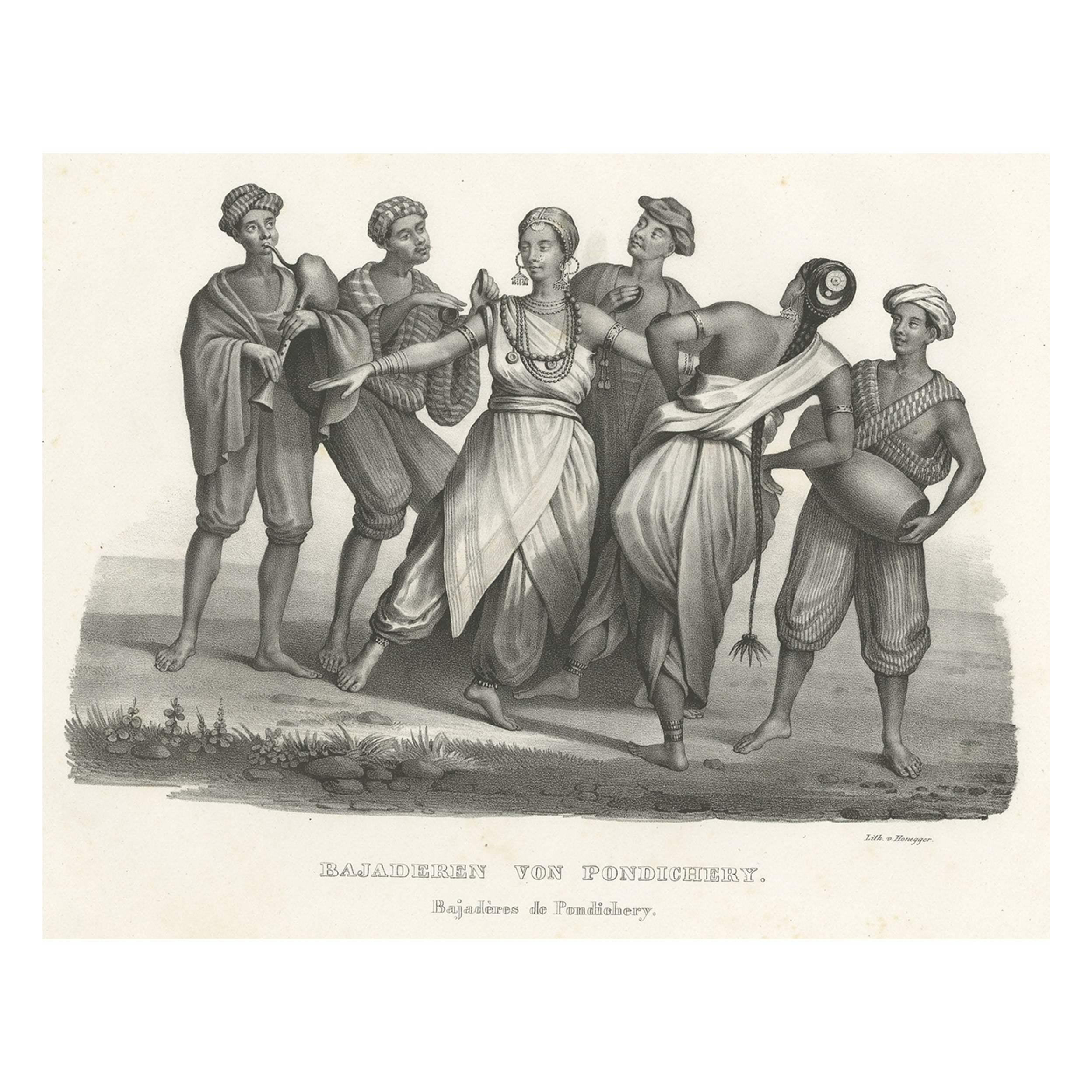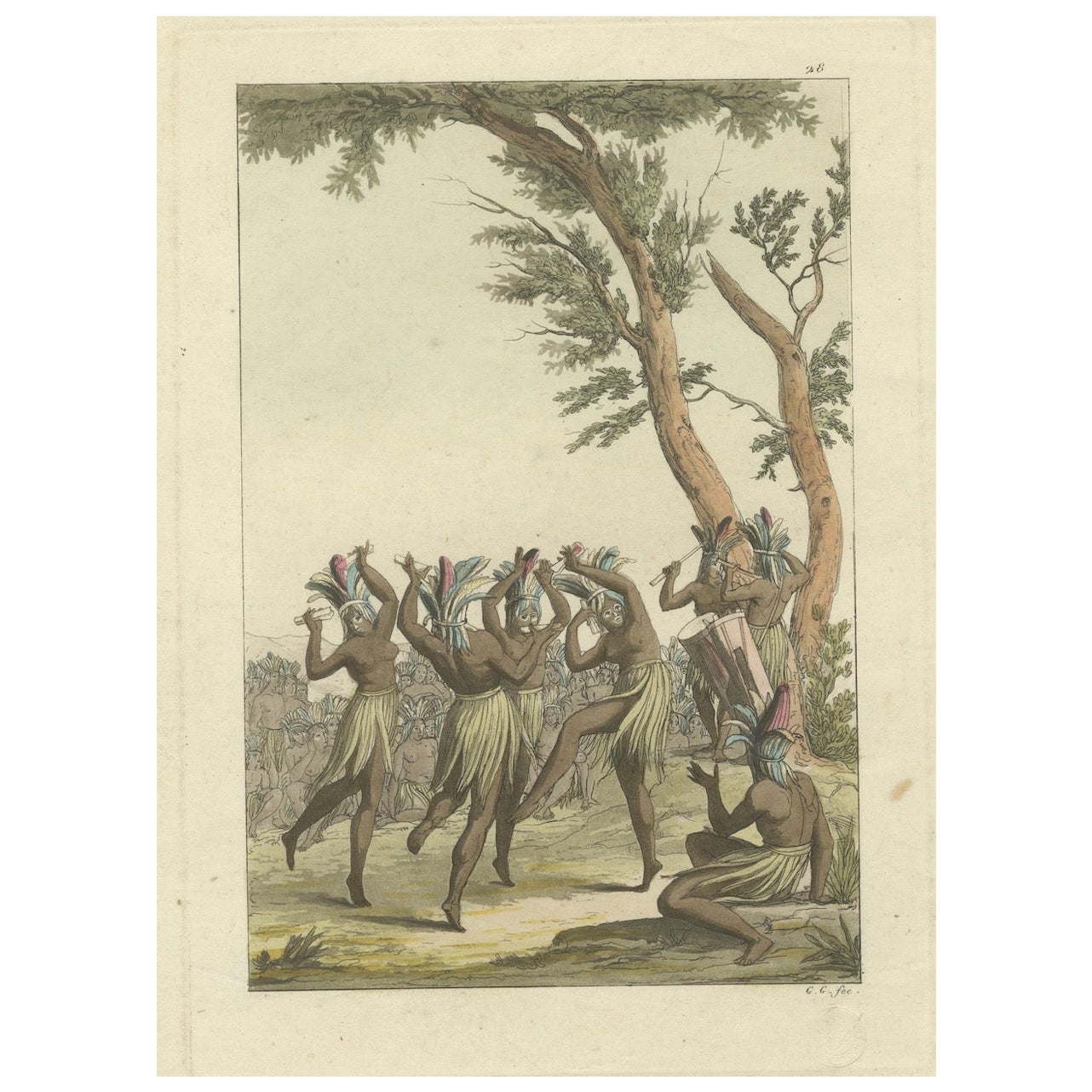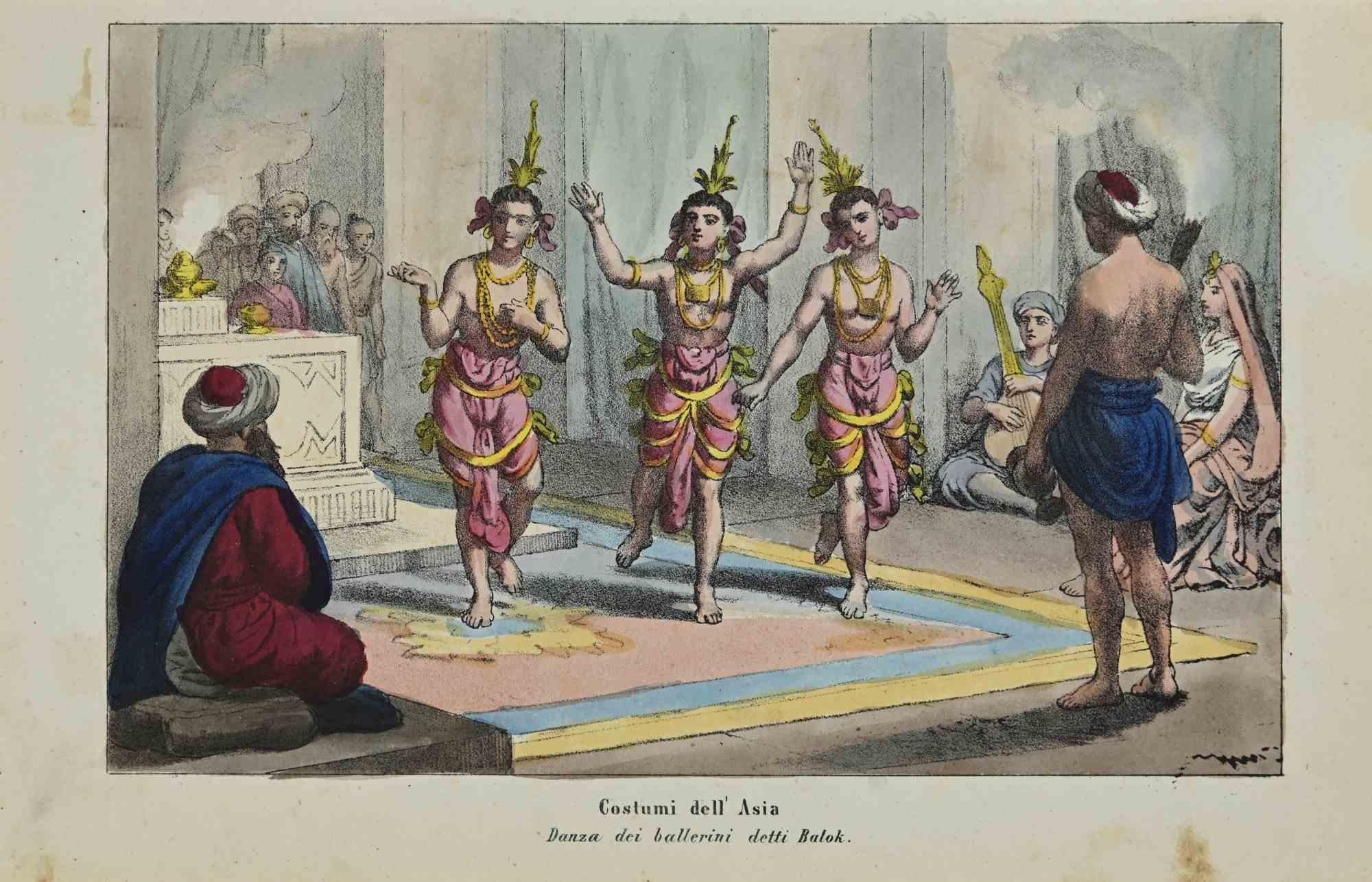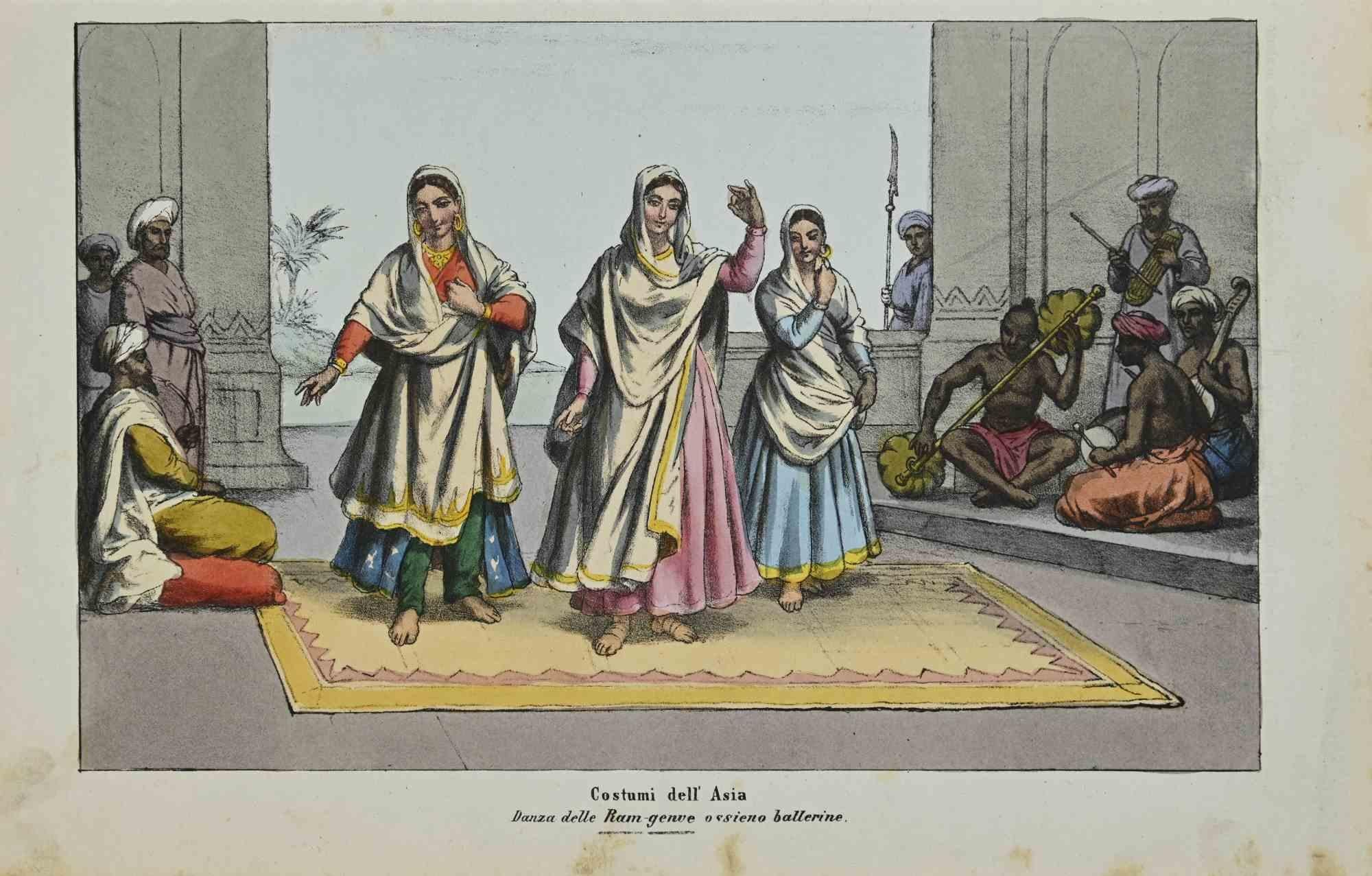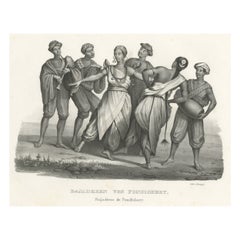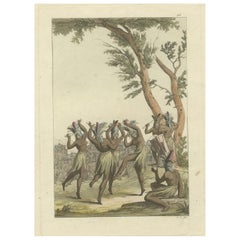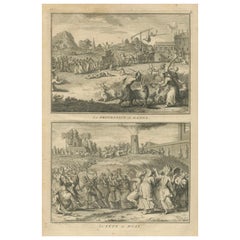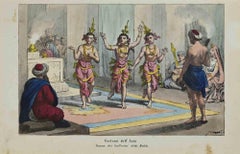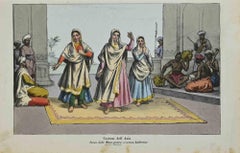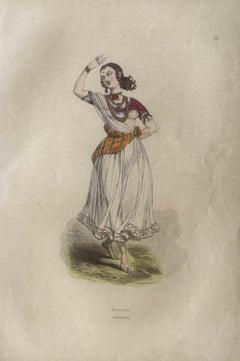Items Similar to Dance of the Bayadères – Sonnerat Engraving Depicting Indian Temple Dancers 1806
Want more images or videos?
Request additional images or videos from the seller
1 of 10
Dance of the Bayadères – Sonnerat Engraving Depicting Indian Temple Dancers 1806
$372.86
£281.21
€320
CA$515.51
A$577.46
CHF 303.30
MX$7,021.75
NOK 3,840.82
SEK 3,645.97
DKK 2,436.05
About the Item
Dance of the Bayadères – Sonnerat Engraving Depicting Indian Temple Dancers, 1806
This lively engraving titled *Danse des Bayadères* (Dance of the Bayadères) is plate number 9 from Pierre Sonnerat’s *Collection de Planches pour servir au Voyage aux Indes Orientales et à la Chine*, published in its second edition in Paris by Dentu in 1806. Bayadères—derived from the Portuguese *bailadeira*, meaning dancer—was the French term for *devadasis*, the traditional female temple dancers of India.
The image captures a scene of dance and music within a lush, enclosed garden or palace courtyard. At the center, two bayadères perform an expressive ritual dance, characterized by graceful hand gestures, rhythmic movement, and dramatic facial expressions. Their bodies are adorned with jewelry and flowers, and they wear traditional striped garments that emphasize motion. A third woman, perhaps a singer or musician, stands calmly to the left, while three male figures provide accompaniment or act as attendants—one carrying a tray of instruments or offerings, another possibly playing a percussive rhythm on a drum.
In the background, tall palm trees and a low enclosure wall establish a serene, tropical ambiance typical of southern India. The architecture is subdued, allowing the dynamic motion of the dancers to take visual precedence. The composition balances theatricality with cultural observation, making this one of the most animated and engaging plates in the series.
This engraving reflects the Enlightenment-era European fascination with Indian temple traditions, particularly those involving ritual music and dance. Sonnerat, though a naturalist and explorer, paid careful attention to sociocultural rituals, and his artists and engravers conveyed these with theatrical flair. Though the Western understanding of devadasis was often filtered through exoticism and misunderstanding, this plate remains a significant historical document.
Condition:
Good condition. Clear impression on laid paper with the original centerfold as issued. Some light foxing near the upper and side margins. Blank verso. Minor toning consistent with age.
Framing suggestion:
A horizontal mat opening with extra width on the top and bottom will best present this animated scene. Use a dark wood or simple gold frame to highlight the fine linework and retain the neoclassical tone of the engraving. Ideal for display in dance studios, cultural institutions, or historical collections.
- Dimensions:Height: 11.23 in (28.5 cm)Width: 15.75 in (40 cm)Depth: 0.01 in (0.2 mm)
- Materials and Techniques:Paper,Engraved
- Period:
- Date of Manufacture:1806
- Condition:Good condition. Clear impression on laid paper with the original centerfold as issued. Some light foxing near the upper and side margins. Blank verso. Minor toning consistent with age.
- Seller Location:Langweer, NL
- Reference Number:Seller: BG-13429-91stDibs: LU3054345002262
About the Seller
5.0
Recognized Seller
These prestigious sellers are industry leaders and represent the highest echelon for item quality and design.
Platinum Seller
Premium sellers with a 4.7+ rating and 24-hour response times
Established in 2009
1stDibs seller since 2017
2,517 sales on 1stDibs
Typical response time: <1 hour
- ShippingRetrieving quote...Shipping from: Langweer, Netherlands
- Return Policy
Authenticity Guarantee
In the unlikely event there’s an issue with an item’s authenticity, contact us within 1 year for a full refund. DetailsMoney-Back Guarantee
If your item is not as described, is damaged in transit, or does not arrive, contact us within 7 days for a full refund. Details24-Hour Cancellation
You have a 24-hour grace period in which to reconsider your purchase, with no questions asked.Vetted Professional Sellers
Our world-class sellers must adhere to strict standards for service and quality, maintaining the integrity of our listings.Price-Match Guarantee
If you find that a seller listed the same item for a lower price elsewhere, we’ll match it.Trusted Global Delivery
Our best-in-class carrier network provides specialized shipping options worldwide, including custom delivery.More From This Seller
View AllMusicians and Bajadere Dancers from Pondicherry, India, ca.1845
Located in Langweer, NL
Antique print titled 'Bajaderen von Pondichery, Bajadères de Pondichery'.
This print depicts musicians from Pondicherry, India.
Europeans referred to exotic Indian dancers as...
Category
Antique 1840s Prints
Materials
Paper
$316 Sale Price
20% Off
Ritual Dance: Expressions of Cultural Heritage in an African Ceremony, 1827
Located in Langweer, NL
The print is from "Il Costume Antico e Moderno" by Giulio Ferrario, specifically depicting the "Le Lullunge" feast in Senegambia. This festival is illustrated as part of the extensive series detailing the customs, costumes, and daily life of people from different parts of the world. The illustration captures a lively and culturally significant dance that forms part of the "Le Lullunge" celebrations, showcasing traditional attire and communal participation, which are central to the event in Senegambian culture. The illustration not only serves as a vibrant representation of the dance and celebration but also as an ethnographic record from the early 19th century, emphasizing the richness of Senegambian traditions.
The term "Senegambia" historically referred to a region in West Africa that encompassed parts of what are today known as Senegal and The Gambia. This area is known for its rich cultural heritage, including vibrant festivals and communal celebrations like the one depicted in the illustration. The "Le Lullunge" feast, as illustrated in Giulio Ferrario's "Il Costume Antico e Moderno," captures the traditional dances and social practices of the peoples in this West African region.
This original antique hand-colored print depicts a vibrant scene of Native African dance, possibly part of a ceremonial or ritualistic activity. The individuals are animatedly engaged in dance, with their limbs dynamically positioned, suggesting vigorous movement. Each figure is adorned with elaborate feathered headdresses and carries feathers or other items as part of their dance. These accessories likely have cultural significance, possibly denoting status, role in the ceremony, or spiritual symbolism.
The attire of the dancers is simple yet functional for their vigorous activity, consisting of skirts that allow for ease of movement. Their outfits are decorated with additional elements that may indicate tribal affiliation or personal achievement. The dancers are barefoot, connecting them physically and symbolically to the earth, which is a common aspect in many African cultural practices emphasizing a connection to nature.
The setting of the dance is outdoors, under a large tree, indicating the importance of natural surroundings for the event. This could be a communal gathering place, chosen for its significance within their community or for its natural beauty and tranquility.
Overall, this image captures a moment of cultural expression, highlighting the importance of dance in Native African traditions as a form of communication, celebration, or spiritual practice. The detail and color used in the depiction aim to convey the vibrancy and energy of the scene, reflecting the artist’s perspective on these cultural practices.
In more detail:
From: ‘Il Costume Antico e Moderno …, l’America.’ , by Giulio Ferrario, published in Milan in 21 volumes by Antonio Fortunato Stella in 1827 (first edition, second issue). The 17 volumes of the first issue were published sequentially between c. 1815/1816 until 1826 after first being issued in 143 weekly installments. The work appeared in Italian and French. Smaller size editions with smaller much less elaborate plates were published in Florence (1823-38), Naples (1831-42) and even a 16mo. editon in Livorno (1830). Original blindstamp at bottom right image. The sources used for this work are wide.
Made by ‘Gallo Gallina’ after ‘Giulio Ferrario’. Giulio Ferrario was founder of the ‘Societa Tipografica de Classici Italiani’ and served as the director of the Braidense National Library in Milan, Italy. Artists that worked on this monumental work are: Gallo Gallina, D.K. Bonatti, A. Biasioli, L. Rossi, Paolo Fumagalli, Gaetano Zancon (1771-1816), G. Bigatti, C. Bramati, G. Gallo, C. Bottiglia, G. Castellini, Antonio Rancati (1784-1816), Vittorio Raineri, Sydney Parkinson...
Category
Antique 1820s Prints
Materials
Paper
$233 Sale Price
20% Off
Ottoman Rituals and Dancers – 1734 Engraving of Turkish Love, Ceremony and Dance
Located in Langweer, NL
Ottoman Rituals and Dancers – Rare 1734 Engraving of Turkish Love, Ceremony, and Dance
This finely executed copperplate engraving, published in 1734 as part of the monumental work L...
Category
Antique 1730s Prints
Materials
Paper
Procession of Ganga and Festival of Huly – Antique 18th Century India Engraving
Located in Langweer, NL
Title: Procession of Ganga and Festival of Huly – Antique 18th Century India Engraving
Description:
This striking copperplate engraving, published aro...
Category
Antique 1730s Prints
Materials
Paper
Antique Print of a Night Dance by Women from Hapaee by Cook, 1803
Located in Langweer, NL
Antique print titled 'Nacht-Dans Vrouwen op Hapaee'. This print depicts a night dance by women from Hapaee. Originates from 'Reizen rondom de Waereld' by J. Cook. Translated by J.D. ...
Category
Antique Early 19th Century Dutch Prints
Materials
Paper
$251 Sale Price
20% Off
Hindu Funeral Ceremony – Vaishnavite Rites, Sonnerat Engraving, Paris 1806
Located in Langweer, NL
Hindu Funeral Ceremony – Vaishnavite Rites, Sonnerat Engraving, Paris 1806
This powerful engraving titled *Funérailles des Indiens de la secte de Vichenou* (Funeral of the Indians o...
Category
Antique Early 1800s Prints
Materials
Paper
You May Also Like
Balok Dancers - Lithograph - 1862
Located in Roma, IT
Customs -Balok Dancers is a Hand-colored lithograph on paper realized in 1862.
Titled on the lower.
The artwork belongs to the Suite Uses and customs of all the peoples of the univ...
Category
1860s Modern Figurative Prints
Materials
Lithograph
Ram Genie Dance - Lithograph - 1862
Located in Roma, IT
Customs -Ram Genie Dance is a Hand-colored lithograph on paper realized in 1862.
Titled on the lower.
The artwork belongs to the Suite Uses and customs of all the peoples of the un...
Category
1860s Modern Figurative Prints
Materials
Lithograph
Uses and Customs - Indian Dancer - Lithograph - 1862
Located in Roma, IT
Uses and Customs - Indian Dancer is a lithograph on paper realized in 1862.
The artwork belongs to the Suite Uses and customs of all the peoples of the universe: " History of the go...
Category
1860s Modern Figurative Prints
Materials
Lithograph
Dance called the Candiotta - Lithograph - 1862
Located in Roma, IT
Dance called the Candiotta is a lithograph on paper realized in 1862.
The artwork belongs to the Suite Uses and customs of all the peoples of the universe: " History of the governme...
Category
1860s Modern Figurative Prints
Materials
Lithograph
Dance Fresco - Etching by Nicola Billy - 18th Century
Located in Roma, IT
Dance Fresco from "Antiquities of Herculaneum" is an etching on paper realized by Nicola Billy in the 18th Century.
Signed on the plate.
Good conditions with some folding due to th...
Category
18th Century Old Masters Figurative Prints
Materials
Etching
Orientalist Gravure Scene of Turkish Women Dancing in the Harem, Luigi Crosio
By Luigi Crosio
Located in North Hollywood, CA
Orientalist Moorish gravure scene of Turkish women dancing in the harem.
After Luigi Crosio (Italian, 1835-1916), Moorish Scene, "The Dancer"
Luigi Crosio...
Category
Early 20th Century Italian Moorish Decorative Art
Materials
Paper
More Ways To Browse
India Musicians
Antique Fox Jewelry
Antique Portuguese Jewelry
Temple Jewellery Antique
Indian Tree Plates
Temple Drum
Antique Indian Drum
Balinese Antique Art
Bamboo Pen
Bargueno Cabinet
Bathroom Vanity Stone
Bed Steps
Bernardaud Vintage
Blaeu Wall Map
Brass Bound Bucket
Brass Clam Shell
Brass Clock Garniture
Brass Deer
